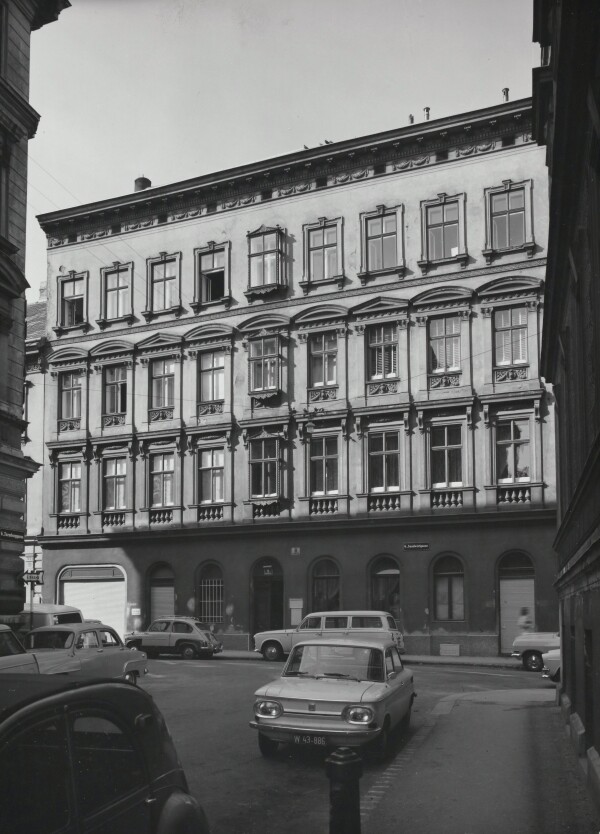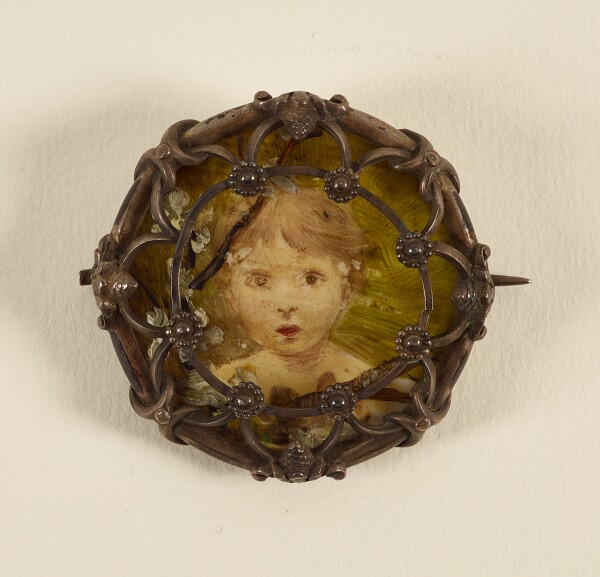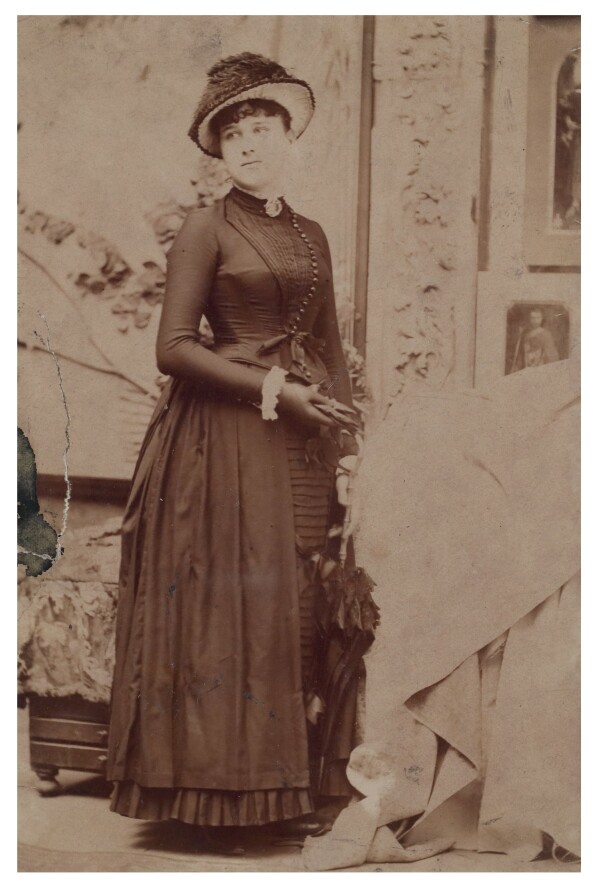Studio at Sandwirtgasse 8

Gustav Klimt's studio in Sandwirtgasse, undated, Verbleib unbekannt
© Klimt Foundation, Vienna

Gustav Klimt: Portrait of a Child with Flowers (Miniature), circa 1883, ARGE Sammlung Gustav Klimt, Dauerleihgabe im Leopold Museum, Wien, Permanent Loan, Leopold Museum, Vienna
© Leopold Museum, Vienna

Insight into the studio of Franz Matsch and the Klimt brothers, 1883/84, Klimt Foundation
© Klimt Foundation, Vienna
Once the “Künstler-Compagnie” surrounding Gustav Klimt had realized several commissions at their studio at the Imperial-Royal School of Arts and Crafts (now University of Applied Arts Vienna), the triumvirate of young artists were able to rent their own studio at Sandwirtgasse 8 in 1883. There, they executed numerous further commissions.
Following the completion of the curtain for the municipal theater in Reichenberg (now Liberec) in 1883, the “Künstler-Compagnie” left their studio at the Imperial-Royal School of Arts and Crafts. The manufacturer of silverware, Adolf Markowitsch, placed the top floor of his factory at Sandwirtgasse 8 in the 6th District of Vienna at the artists’ disposal free of charge. In return, the Klimt brothers and Franz Matsch provided Markowitsch with designs for silver jewelry and painted enamel plates. It is further believed that the young painters realized a tondo for the building’s entrance hall, depicting a putto playing the trumpet. However, the work has been moved from its original location and its present whereabouts are unclear.
We do not know how the three painters got acquainted with the factory owner. It is possible that there was a connection through Gustav and Ernst Klimt’s father who, as a gold engraver, likely mixed in similar circles as the trained gold- and silversmith Markowitsch.
Commissions at the Sandwirtgasse Studio
For the Klimt brothers and Franz Matsch, having their own studio meant that they were able to realize larger and more prestigious commissions, which were not linked to the School of Art and Crafts. In a letter dated 2 February 1884 and addressed to Rudolf von Eitelberger, the director of the Imperial-Royal Austrian Museum of Art and Industry (now MAK – Museum of Applied Arts), the three artists stressed several times that they were now ready to take on even larger commissions on account of their new workspace. They were especially interested in carrying out commissions for buildings along the Vienna Ringstraße:
“In closing, we would like to point out that, thanks to the head of the company A. Markowitsch, who has selflessly placed a suitable studio at our disposal, we will be in a position to adhere to the above-mentioned program [NB: working together on commissions swiftly and in a consistent style].”
Indeed, the artists of the “Künstler-Compagnie” celebrated their first major successes with works created at the Sandwirtgasse studio. Likely thanks to a recommendation from Rudolf von Eitelberger, they received the bulk of their commissions from the architectural office Fellner & Helmer, who specialized in the construction of theaters. From 1884 to 1886, the young artists worked on the decorative paintings for the municipal theaters in Fiume (now Rijeka) and Karlsbad (now Karlovy Vary). Additionally, they decorated the Hermesvilla in Lainz with ceiling paintings for Empress Elisabeth.
The artists also realized their ambitious goal of carrying out decorative paintings for buildings along the Vienna Ringstraße. In 1886, the “Künstler-Compagnie” was commissioned to decorate the staircases of the newly built Imperial-Royal Hofburgtheater (now Burgtheater) with a decorative program that visualizes the history of the theater. Klimt’s painting Shakespeare’s Globe Theater (1886–1888, Burgtheater, Vienna) includes portraits of his brother Ernst and Franz Matsch, as well as a self-portrait. In 1890, the artists received the commission to decorate the staircase of Vienna’s Kunsthistorisches Museum [Museum of Art History] with allegories of the pre-eminent stylistic eras in art. For the individual scenes’ protagonists, numerous photographs were taken in the studio of family members and friends as models, giving us a good idea of what the rooms on Sandwirtgasse looked like.
Success and Move to a New Address
The numerous commissions not only increased the painter trio’s social and artistic standing but also lead to an improvement of their financial situation. Moreover, Klimt was awarded the Emperor’s Prize (with a prize money of 400 ducats, now c. 25,000 euros) in 1890 for his large-scale gouache Auditorium of the Old Burgtheater (1888, Wien Museum, Vienna). In this work, Klimt portrayed his brother Ernst along with various personalities from high society. This likely paved his way into the circles of his future commissioners. Their improved financial situation allowed the artists of the “Künstler-Compagnie” to rent a new studio. From 1891, the Klimt brothers and Franz Matsch appeared in the address register Lehmann’s allgemeiner Wohnungsanzeiger under a new work address in the 8th District of Vienna, at Josefstädter Straße 21.
Literature and sources
- Brief von Franz Matsch in Wien an Rudolf Eitelberger in Wien, mitunterschrieben von Ernst und Gustav Klimt (02/02/1884). H.I.N. 22.439, .
- Herbert Giese: Franz von Matsch – Leben und Werk. 1861–1942. Dissertation, Vienna 1976.
- Sandra Tretter, Peter Weinhäupl (Hg.): Chiffre: Sehnsucht – 25. Gustav Klimts Korrespondenz an Maria Ucicka 1899–1916, Vienna 2014.
- Alice Strobl (Hg.): Gustav Klimt. Die Zeichnungen, Band I, 1878–1903, Salzburg 1980, S. 68-73.
- Adolph Lehmann's allgemeiner Wohnungs-Anzeiger. Nebst Handels- u. Gewerbe-Adressbuch für d. k. k. Reichshaupt- u. Residenzstadt Wien u. Umgebung, 33. Jg. (1891), S. 779.
- Gerichtshalle, 06.02.1882, S. 6.
- Agnes Husslein-Arco (Hg.): Gustav Klimt und die Künstler-Compagnie, Ausst.-Kat., Upper Belvedere (Vienna), 20.06.2007–14.10.2007, Weitra 2007.

